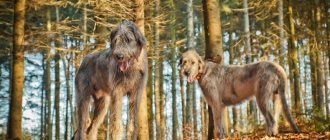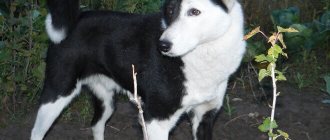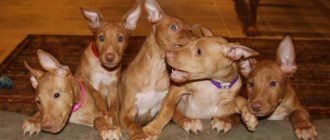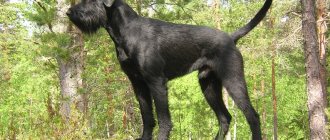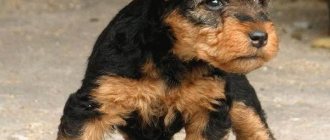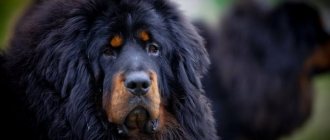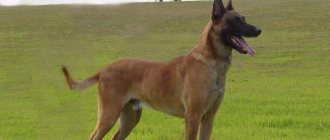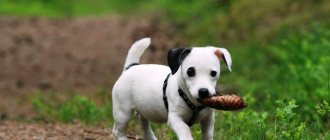| Origin | Great Britain |
| Usage | Hunter, companion |
| Color | Cheprachny |
| Dimensions | Height at withers 33-38 cm, weight 8-11 kg. |
| Lifespan | 11-14 years old. |
The Welsh Terrier is a true terrier originally from England, Wales. This is an affectionate, easy to train dog. Fearless, childishly playful, completely non-aggressive, can become a family dog. The preserved hunting instincts allow the dog to be used as a faithful assistant when hunting foxes, badgers and other small burrowing animals. The Welsh Terrier loves noisy companies, loves to be the center of attention, and has difficulty enduring long periods of loneliness. A complete description of the breed will help you get acquainted with the pros and cons of Welsh Terriers.
Care and maintenance
The breed is unpretentious and compact in size, so it is suitable both for keeping in a private house and for an apartment.
The house needs to be equipped with an enclosure with a booth. The fence must be made high enough, otherwise the dog will be able to overcome it. The dog needs long walks with active training and games (with a stick or ball). While walking, she barks loudly, jumps high, and runs. If you don't spend enough time walking, the dog will start jumping around the house and destroying everything in its path, thus getting rid of excess energy. After a walk in bad weather, you need to wash your paws, belly and face. You should periodically clean your ears and trim your nails.
You need to wipe your eyes regularly, removing dust and hair that accumulate in the corners. This is done using a cotton swab and chamomile decoction or tea. You can brush your teeth with baking soda or a special toothpaste for dogs. Otherwise, plaque appears on them, which can develop into tartar.
The coat requires special care. The dog should be brushed regularly and bathed once a week. To comb, you need to purchase a steel comb (to remove mature hair) and a brush with wire bristles (for combing and massage). The shedding is invisible, the hair practically does not fall out, so the dog can be recommended to people who are allergic to it. However, your pet needs to be trimmed a couple of times a year. The dog needs trimming: for show dogs once a month, in other cases once every six months. It begins to be done at 4 months. You can cut your hair at home or sign up for grooming at a salon. If you neglect grooming, the dog will become unkempt.
Some owners get dogs for mating and further breeding. It should be remembered that for this purpose the girl is brought to the male, and not vice versa. Firstly, a male dog behaves more actively at home, and secondly, if he is brought to a female dog, he can remember the way and visit her. If mating is not planned, it is better to sterilize the bitch.
What to feed
Welsh Terriers are not picky eaters. The choice is between dry food or natural food. The food must contain all the necessary vitamins. They are purchased at veterinary clinics.
The diet usually consists of:
- meat (small puppies need to boil it and chop it finely);
- cottage cheese (it is advisable to have breakfast with this product, diluting it with kefir);
- porridge (buckwheat and rice);
- eggs (twice a week);
- fruits and vegetables.
Strictly prohibited:
- salt, sugar, spices;
- potato;
- flour products.
There are allergies to some dry food. It is also possible when introducing a new product into the diet.
It is important to maintain the correct portion size, the dog should eat enough, but not overeat or starve
Reproduction and lifespan
Welsh Terriers live from 14 to 16 years. They are considered long-living dogs. The breeder of this breed must know everything about it: exterior parameters, acceptable color, deviations from the norm, habits, etc. This is required to select high-breed parents who will give healthy offspring.
So, a sexually mature Welsh bitch should get acquainted with a male dog no later than 3-4 days from the start of estrus. During this period, all conditions are prepared in her body for conception. A sexually mature male will immediately demonstrate his interest to her. If this does not happen, for example, because the bitch is aggressive towards him, their meeting should be rescheduled.
Puppies are born approximately 70 days after mating. The Welsh bitch takes care of them. Its owner should interfere in their “affairs” only if one of the dogs is being crushed by others. This happens, especially if the litter is large.
Advice! Choose an active and playful terrier. A sedentary dog of this breed is likely to be sick or depressed.
Maintenance, care, nutrition
The Mini Airedale Terrier is not a fussy eater, but there must be balance in the diet. Food is allowed both natural and in the form of ready-made food, which already contains all the necessary elements.
If you have chosen exclusively natural food for your pet, then it should contain the following dishes:
- Meat (preferably chicken or cow);
- Hard-boiled eggs;
- Buckwheat or rice porridge;
- Vegetables and fruits are thoroughly washed;
- Growth supplements;
- Low-fat kefir or cottage cheese;
- Boiled fish without bones.
Puppies need six meals a day, while adults are limited to two meals a day. The diet should be changed as often as possible
Regarding care, it is important to note that the coat of this breed does not shed, but several times a year the pet must be taken for hair plucking - this is a kind of haircut typical for this breed
Also, every week the dog should be combed with a special brush to remove excess dirt.
Eyes and ears must be thoroughly cleaned with special wipes several times a week. Hydrogen peroxide can also be used to treat ears. It is allowed to bathe the dog as soon as it gets dirty, but the paws should be washed after each walk.
Health
Welsh Terriers are considered a healthy breed, not burdened with hereditary diseases. After all, they were bred as working dogs, and strong and healthy individuals were selected for breeding.
Diseases
The following diseases are rarely observed:
- Eye diseases: conjunctivitis, glaucoma, cataracts.
- Food allergies.
- Dermatitis.
- Epilepsy.
Timely routine medical examination can detect the disease at an early stage. Therefore, an annual examination by a veterinarian is necessary. Regular treatment against fleas and worms, as well as vaccination according to the established schedule, will ensure the animal a long and active life.
Vaccinations
According to the standard immunization schedule, the first vaccination is given to a Welsh Terrier puppy at 9-10 weeks of age. Earlier vaccination is not advisable: for the first two months of their life, puppies are reliably protected by the immunity received from their mother.
The table shows the standard vaccination schedule.
| Age | Vaccination appointment |
| 9-10 weeks | Against canine plague; enteritis; parvovirus; parainfluenza. |
| 12-13 weeks | Revaccination of previous vaccination; a new rabies vaccine is being added. |
| 6 months | Vaccination against all previously identified diseases. |
| 1 year | Vaccination against all previously identified diseases. |
Then, throughout its life, the dog is vaccinated once a year.
After each immunization event, the dog is provided with gentle conditions:
- limit physical activity;
- they are not allowed to walk outside;
- no new foods are introduced into the diet;
- refrain from bathing your pet.
Training
They are easy to work with in the training process, so they will be an excellent choice for those owners who have not had experience caring for our smaller brothers before. They are still independent, like their brothers, so sometimes they simply will not listen to you, no matter what you do. But this does not mean that the pet is stupid, not at all; rather, on the contrary, he is very smart, he just needs an incentive.
When he knows that he will receive a treat, for example, or praise for his work, he will plunge headlong into the process. Therefore, always have something tasty on hand and as much as possible. Training should begin as early as possible, since younger children are more amenable to the learning process. Classes should be kept short, varying the pace and activity as much as possible.
He should not be given freedom of action so that he does not take over your leadership, since, having such a character trait as independence, it is quite possible that this will play a cruel joke on you later. Always show your dominance and never let him break the rules or deviate from them. Always remember one thing, giving him freedom and allowing him to retreat a centimeter, he will go a kilometer.
The Welsh Terrier breed is an excellent watchdog that will warn you of the approach or entry of a stranger into your territory or possessions. Since this is in his blood, and happens at the level of instincts, it is necessary to include commands to stop barking in his training, otherwise he can drive you and your neighbors crazy.
He has a neutral attitude towards other animals, and for no reason he will not pick on them, unlike the Bull Terrier. But if a challenge is thrown at him, he will not back down and will stand until the last, regardless of the size and weight of the enemy. It should also be noted that poorly socialized individuals can still be aggressive.
In order for him to develop correctly, you must provide him with interaction with other animals as early as possible, so that he understands that strange pets are not always a threat.
Socialization
Early socialization is necessary for the Welsh Terrier, because stubbornness and independence are inherent in the character at the genetic level. A socialized dog obeys not instincts, but the demands of the owner.
Usually a puppy goes to a new home at the age of 2 months. The familiar environment surrounded by brothers and sisters changes to a new, unfamiliar space. Getting to know other family members and instilling basic rules of behavior is necessary to shape the pet’s character.
The Welsh Terrier treats other dogs living in the same territory with restraint. But he can perceive an adult cat as prey. But it can also become a good friend if the animals entered the house at the same time at an early age.
Welsh Terriers love children and will never hurt them. They will keep company in joint games and mischief.
Breed dossier
1. Country of origin: Great Britain.
2. Classification: Group 3. Terriers. Section 1. Large and medium terriers.
3. Training. Welsh Terriers are active and willful dogs, they love training and games, but can be extremely stubborn and difficult to train. When raising this dog, you should show strength of character and endurance, because the Welsh Terrier loves to test the owner’s patience and stubbornly refuse to follow this or that command.
4. Color: black and white. The back is darker, brown or black, and the belly and limbs are red.
5. Dimensions. Height at the withers: males: 37 - 40 cm, females 33 - 36 cm. Weight: 9 - 10 kg.
6. General impression: a small dog of compact size, angular, rectangular in format. In appearance it is a bit like an Airedale Terrier.
7. Use: hunting dog, companion dog.
8. Physical activity: active. The Welsh Terrier is a very active and energetic dog breed that loves movement and communication. This dog happily brings his owner a ball, a stick, or a frisbee. It is best to walk this dog in nature so that it can get plenty of exercise. It is very good if you have the opportunity to send your Welsh Terrier to a special school where dogs are taught commands.
9. Character: active, energetic. Welsh Terriers require a lot of attention to their person. These dogs love to be the center of everyone's attention, so they are ready to play pranks all day long just to be looked at. Representatives of this breed are perfect for noisy families who lead an active lifestyle and are often outdoors. If raised incorrectly, a Welsh Terrier can become aggressive and embittered. This dog is characterized by pugnacity. The Welsh Terrier loves to get into fights with other dogs if he sees them fighting. He himself does not provoke anyone, but he is ready to bark and bite for company.
11. Grooming: labor intensive. The Welsh Terrier has a coarse coat of medium length; haircuts for this dog are contraindicated by the standard, because a regular haircut spoils the structure of this dog's coat. Instead of a haircut, a Welsh Terrier needs to be trimmed (specially plucked hair) twice a year. It is better to leave this procedure to a specialist.
12. Accommodation: average. Welsh Terriers can be aggressive towards other pets, and jealousy is also inherent in these dogs.
13. Diseases: eye diseases, skin dermatitis.
14. Diet: balanced.
15. Life expectancy: 12 – 14 years.
Photo: Welsh Terrier
Appearance of Welsh Terrier dogs
Externally, Welsh Terriers are very similar to Airedale Terriers. These are wire-haired dogs with an elongated rectangular muzzle, long mustache and beard. But the Welsh Terrier is smaller in height - the height at the withers does not exceed 40 cm. According to the standard, the weight, regardless of gender, should be 9-10 kg.
Head
The head is long, narrow, almost flat between the ears. The muzzle is elongated, rectangular in shape. The transition from forehead to nose is almost invisible. The jaws are powerful, with a strong grip. Cheekbones are defined, teeth are strong. The bridge of the nose is straight, the lobe is large, black.
The eyes are small, almond-shaped, dark in color. Set deep, should not be convex. The look is smart and cheerful. The ears are also small and set high. They are shaped like the letter V, hang down, and fit tightly to the head.
Frame
The physique is harmonious, the body is square. The neck is gracefully curved, smoothly blending into the shoulders. The withers are well defined, the chest is moderately wide and deep. The back is short, the loin is slightly convex. The host is set high, straight or saber-shaped. The dog carries it vertically, the tip may be slightly curved. Previously, Welsh dogs had their tails docked, but this is now prohibited in many countries.
Limbs
The limbs are straight, strong, set parallel. The shoulder blades are long, the hock joints are low. The hind legs are set slightly at an angle, the thighs are elongated and muscular. The paws are small, the toes are collected. The movement is sharp and energetic. When running, the limbs move in parallel.
Coat and color
Welshies are wire-haired dogs. They have a thick, short, double coat. The guard hair is wiry, coarse, and has a porous structure. It curls a little, which makes the dog look a little disheveled. The haircut makes it softer. The undercoat is dense, dense and soft. Thanks to this, the coat does not get wet.
According to the breed standard, the color of the Welsh Terrier should be black and tan. The black color should be located in the upper part of the body. The limbs and muzzle are red or brown, grayish is allowed. There should be no white spots.
At birth, Welsh Terriers are black in color, but the red color appears at 4 months. The final coloring is formed by 2 years. Another feature of dogs of this breed is that the hair does not fall out, so it needs trimming.
Photos complement the description of the appearance:
Similar breeds
Externally, Welsh Terriers are similar to several types of terriers. Most often they are confused with Airedale Terriers, considering them a mini variety, since they are smaller in height. The main difference is their purpose. Airedale terriers were bred to hunt otters, and Welsh dogs were bred to hunt burrowing animals. There are also such differences in appearance:
- the Welsh has a longer and wider head;
- the Airedale's ears are directed downwards rather than towards the eyes;
- The Airedale can throw its tail over its back, but this is unacceptable for the Welsh.
The breed is also similar to fox terriers. But Welsh are more active, with pronounced hunting skills. Fox Terriers have a different color - white with spots, a narrower and elongated muzzle.
The photograph shows the differences with similar breeds:
Characteristics of the Welsh Terrier breed
Today there are two breed subtypes:
- worker;
- exhibition.
The difference lies in the general features of the figure and the characteristics of the coat: a working dog is stronger than a show dog and has a coarser coat.
Color: red-brown with black or gray-black saddle. Black color on the bottom of the paws is undesirable. The classic black saddle color appears at two years of age, before which they are black and tan.
General form:
- A short dog of proportional build, “square” format, not wide-bodied, with a narrow chest.
- The tail is strong and set high. In countries where there is no ban, the tail is docked so that its end is at the same level as the occipital protuberance.
- The head is rectangular.
- The eyes are dark brown, almond-shaped, set wide apart.
- The nose is black, powerful, square.
- Typical exterior defects of the breed are high stature (especially in males) and lack of teeth.
Health and heredity
For veterinarians, Welsh Terriers are a breed of no interest, since the dogs' health is excellent. They are very hardy and have excellent immunity. However, among these strong dogs there is a breed predisposition to certain diseases of the organs of vision that appear with age:
- cataract;
- glaucoma;
- dislocation of the lens of the eye.
Genetic diseases manifest themselves in the form of atopy, a difficult-to-treat dermatosis, and hypothyroidism, a dysfunction of the thyroid gland, which appears in dogs at various stages of maturation. Cases of epileptic seizures, which are also hereditary in nature, are recorded with a certain frequency in Welsh. Dogs not burdened by heredity live up to 16 years or more.
Breed characteristics and character
The Welsh Terrier breed is a cute, friendly, active, agile, kind, energetic, cheerful dog. They are devoted to their master and serve them faithfully all their lives. They are kept as pets and loyal friends.
Breed Features:
- they do not get along in the same house with cats. Their natural, strong hunting abilities will constantly manifest themselves, and the cats will suffer a little from this, since the dog will constantly chase them;
— the Welsh Terrier dog reacts calmly to its relatives of other breeds. They don't rush into fights unless they get hurt. If this has already happened, then they show themselves to be quite strong rivals, even with much larger individuals;
— dogs are good with children. They love little girls and boys and can run and play with them for hours, considering them their best friends and partners. In addition, the dog will be a faithful guard and protector of your children;
— the Welshman requires daily active and long walks. It could be a forest, a planting, a square, a city park, or any body of water. They swim very well, and especially love to roll around in the snow;
- they can live both in an apartment and in a private house;
— Welsh Terrier puppies must be trainable, starting from the day they are brought into the home. They are able to quickly learn commands and obey their owner;
— Welsh Terrier males are characterized by a calmer and more balanced character;
Welsh Terriers on the street in spring
- They love to dig holes in the ground. Therefore, you can be calm - all the flower beds will be dug up;
- this breed requires constant attention and the presence of a person nearby. If they are left alone for a long time, they become depressed, they lose their appetite and the desire to run.
The dog's activity manifests itself from a very young age. Their puppies do not stop for a second, constantly running and playing. With age, they calm down and begin to behave more calmly within the confines of the house, but the same cannot be said about the street.
A cheerful and playful dog will never ignore a dog fight. He is independent, self-confident, has courage and determination, and has the qualities of a leader.
When training, it is very important to let the pet understand that the person is more important and more important than him. This will not be easy and will not be easy, but it is necessary to insist on it
Dogs perceive aggression and force in their direction negatively. Even during training, a person must be calm so as not to anger the dog and not to learn its bad side. He will become embittered, stop obeying and bare his teeth.
Hunting with a Welsh Terrier will be unforgettable. He will quickly find the holes of animals, dig them up, drive the fastest and most nimble hare, and will tirelessly do this as long as necessary. But, you need to take only trained dogs for hunting, so that they understand all the commands the first time and are able to stop at the request of the owner.
Education and training
Welshies are very smart dogs. They learn standard commands not only quickly and efficiently, but also with great pleasure. But they will not learn if they are not interested. Come up with an effective reward system for your pet. For example, reward him with a “yummy” treat for every effort.
So, the main tasks of the owner of a young burrow hunter:
- Teach him to come when called.
- Make him remember his nickname.
- Offer to take the designated sleeping place in the house and treat it as your own.
- Teach how to adequately greet guests, not bark at them or attack them.
- Monitor his interaction with other animals.
Let's take a closer look at the last point. The Welsh Terrier is a ferocious hunter, he often conflicts with dogs, rodents and especially cats, he especially hates them. How to teach an adult dog of this breed to get along with them?
The answer is disappointing - no way. Only a Welsh puppy should be socialized. From an early age, a young dog will begin to identify all living creatures on the territory of the house as members of its pack, so it will not fight with them for territory.
Advice! To prevent the burrow hunter from being jealous of you in the presence of other pets, stroke his head while communicating with them. But don't encourage his growling by stroking him.
A few additional recommendations:
- Teach your animal to relieve itself only outside. If he defecates in the house, scold him and immediately take him out into the yard.
- Be present during his meal. This way you will prevent the formation of so-called food aggression in your pet.
- If he snaps at anyone in the house, scold him. Never ignore your dog's anger for no reason.
- When you walk him outside, hold the leash tightly, especially if there are other dogs nearby. The Welsh may become aggressive towards them and begin to break free. In this case, block his path and pull the leash back firmly. After you establish eye contact with your pet, order him not to react to the others by giving the command “No”.
- It is not recommended to allow a burrow hunter to sleep near you. According to dog handlers, this practice is fraught with the development of a dominant character.
Character
The Welsh Terrier's attitude towards life is always positive. The dog is energetic, lively and very cheerful.
Loves when others pay attention to him. Prefers to be discussed, therefore, when there are guests in the house, he revolves around them
But at the same time, it is not imposed.
The energy in his body is in full swing. He can run around the house for hours without getting tired at all. Then stop for a drink of water and continue. Loves to be petted and cherished. Always friendly with good-natured guests. In their presence, he often forgets about the owner. Likes to get new experiences.
The Welshman has a unique gift from nature - he is able to make decisions depending on the situation. That is, if the dog smells an enemy, that is, a potentially dangerous person, he will, at all costs, try to neutralize him. Family protection is a priority for such a dog. Many burrow hunters are responsible.
A simple impartial walk is unlikely to seem interesting and exciting to such a dog. Without innovation, her life will lose color and become joyless. Be prepared for the fact that your pet will chase birds, hares, squirrels and any other animals in the park. The hunter's instinct in him will never dull.
The Welsh Terrier enjoys good health and remains active into old age.
Welshies are very playful and energetic. They like active recreation. Such a dog will tirelessly run after a ball or stick for several hours. From childhood she needs to be taught to bring it to the person who abandoned her.
He has a specific character trait - ambition. When interacting with other dog breeds, the Welshman expects them to be compliant. He rarely compromises; he prefers to occupy a dominant position. Both males and females strive to dominate the slopes.
It is worth noting that his instinct of self-preservation is significantly inferior to ambition. That is, if a proud Alabai or pit bull gets in the way of a terrier, this will not shake his self-confidence at all. The owner of such a pet should control the process of its interaction with other dogs, because it is prone to conflicts.
He will not miss a single arrival of guests, not a single game. All events occurring in the territory where the Welsh Terrier pack lives will directly or indirectly affect it. An animal will be very upset if it is isolated during something interesting. Requires attention regularly. Sensitive to affection, he himself is prone to its manifestation.
He always feels like a guard in the house. He will not allow small animals to roam around his territory with impunity. Will drive any living creature away from its site: a bird, a hedgehog, a mouse. By the way, the last representative of the fauna may even be torn to pieces.
Terriers hate being alone. They become so attached to their family members that separation from them often ends in stress or illness for them. These animals have another specific character trait - determination. They clearly understand what they want and act accordingly.
Mating
The first mating is an exciting and important moment for the owner, for which one should prepare in advance. First, you need to keep a special journal in which you should note all changes in the dog’s behavior and health, as well as the female’s estrus schedule.
As a rule, the first heat in dogs occurs at 8-12 months of age . Dates can move both shorter and longer, depending on the characteristics of the body. The second and subsequent heats occur with a break of six months. The first mating is possible after the third heat .
Hunting with a Welsh Terrier
In Russian realities, you can successfully fight a fox with a Welsh dog. The breed is distinguished by good viciousness and fiercely attacks the animal in a hole. However, it is better not to count on lightning success, since seasoned foxes can lead a dog by the nose for a long time, winding through underground tunnels. It usually takes Welsh Terriers several hours to wear down a red rogue and drive it out at gunpoint. The process is especially delayed if the hole is old and branched.
The situation is even more complicated with badger holes, which are sometimes occupied by fox families. It can be difficult for a Welshman to navigate this semblance of the Parisian catacombs and often, after being active for several hours, the dog loses interest in the enemy
That is why, when buying a puppy for hunting purposes, it is important to ask the seller how high the degree of viscosity is in the baby’s parents. This quality, like malice towards the beast, is inherited and even an experienced professional cannot easily cultivate it.
In Europe and America, classic hunting is not favored, preferring to replace it with bloodless entertainment. For example, in the USA, Welsh Terriers are used in the sport of barn hunting. The essence of the attraction is to imitate hunting actions using a labyrinth built from straw bales, in which cages with rats are placed. A Welsh Terrier released into a hole must find rodents in the shortest possible time and inform the owner about this.
At the moment, barn hunting is recognized as an official sport by several canine associations. In addition, it does not establish class boundaries for participants (both show pets and pet-class Welsh dogs can compete). In Russia, such “quests” are not yet common, although some pioneers have already built straw labyrinths on their plots, where they successfully train Welsh Terriers and their relatives.
Toy Terriers
The last type of terrier in the official classification is the toy variety.
Yorkshire Terrier
A decorative terrier dog that has received the greatest recognition in the world. It is impossible not to love these sweet companions, because they become attached to their owners from the first day. Yorkies are active, inquisitive, restless, and love to communicate. Based on height, there are three types of individuals: standard, mini and super-mini. The price of a puppy starts from 15,000 and goes up to 60,000.
Australian Silky Terrier (Silky)
A stocky dog with fine silky hair, the length of which reaches 15 cm. The height of an adult is 23 cm, weight - 5 kg. Silky is considered a good-natured companion: he takes training well, obediently follows commands, and loves affection. But the dog is not averse to fighting with its relatives, so the upbringing must be correct. Puppies are sold for 15 thousand rubles or more.
English toy terrier
A rare species with an elegant build and miniature dimensions (height 25-30 cm; weight 3.5 kg). The temperament of individuals is peculiar, but not capricious. The price starts from 30,000 rubles.
Origin story
Welsh Terriers appeared in England a very long time ago, but their targeted breeding began only in the second half of the 19th century. The standard was developed in 1885 and approved in 1886. The Welsh is considered the birthplace of the breed, which is why the dogs are sometimes called Ural Interior. Initially, Welsh dogs were strong and vicious dogs, focused on exterminating small predators and rodents, and were also used to hunt badgers and foxes.
Fox terriers, Irish terriers and Leukend terriers took part in the formation of the Welsh terrier phenotype. In turn, Welsh Terriers were used by German breeders when breeding the Jagd Terrier.
Modern Welsh Terriers are divided into two types: working and show.
In some countries, their breeding is carried out separately, in others the lines constantly intersect. The working type is distinguished by stronger bones and coarse hair, and is used as a helper dog in the hunt for burrowing animals. Sometimes Welsh can be found at customs. A keen sense of smell helps sniffer dogs sniff out drugs and explosives. The show type is distinguished by a softer coat, light bone structure and carriage of the head.
Welsh Terrier character
Welsh Terriers are loving and devoted dogs. They are energetic, very curious and playful. Thanks to their hunting roots, dogs of this breed are hardy and brave. Some of these dogs are aggressive towards other dogs, while others are completely peaceful.
In general, Welsh Terriers are slightly calmer than other larger terriers. But just like most terriers, these dogs are prone to chasing small animals, which is why they can easily run away if left unsupervised.
Dogs of this breed love to swim. Some people like to dig.
Welter Terriers are rarely shy and adapt well to both urban and suburban living conditions. They are wonderful pets for a young, active family. The playfulness and energy of these dogs will greatly appeal to children, with whom these dogs know how to get along well, especially if the children are no longer very young.
Like all terriers, the Welsh Terrier should always be kept busy and spend a lot of time outside. Cables of this breed are usually friendlier, quieter and more even-tempered than females. In general, these dogs are peaceful and rarely aggressive, but if push comes to shove, they become serious opponents.
Dogs of this breed love to spend time with their family. The Welsh Terrier is best suited for active families with older children.
In a country house with a plot, he will be happy to protect your property from rats and other rodents, as well as from the encroachments of strangers. The Welsh Terrier's passion for hunting, due to the origin of the breed, will help him cope with rodents, and the dog will be able to warn you about unwanted guests thanks to his increased distrust of everyone except the owner and his family.
Do you live in the city? The Welsh Terrier will adapt well even in a small apartment, just do not deprive the dog of long active walks. Also, make sure he doesn’t get into fights with other dogs.
The brave heart of a little hunter always calls him to protect his owner from any potential danger!
The Welsh Terrier is well suited for keeping in an apartment if you provide it with daily long walks and sufficient physical activity.
Left unattended for a long time, these dogs are prone to destructive behavior.
Welsh Terriers feel quite comfortable indoors. Living in a metropolis does not create problems for them in terms of getting a fair amount of physical activity. They love to run, chase, jump - in short, all active games, preferably with the owner.
Welsh Terriers are very capricious, sometimes even cocky, they never miss noisy scandals and fun games, and always strive to be the center of attention.
In the hands of an experienced hunter, the Welsh Terrier can very well be a versatile dog. Not all Welsh Terriers work with a grip; some are limited to simply barking. Dogs also differ according to the animal: some work better at a badger, others at a fox.
Initially, Welsh Terriers were used only for hunting burrowing animals and small predators. However, today they are used much more widely. In addition to hunting, Welsh Terriers perform guard and herding functions, and often simply act as human companions.
Among the undoubted advantages of the breed, owners of Welsh Terriers will name the dog’s cheerful disposition, lively character, endless devotion to the owner and elegant appearance as if a dog is dressed in an elegant jacket.
However, if you are not a fan of vigorous canine activity, and are not sure that you will provide your Welsh Terrier with a targeted training program and mandatory coat care, think about whether this is “your” breed? The developed hunting instinct of a dog that has not received proper training can cause a lot of inconvenience to both the owner and his neighbors in the house or country house.
For those who are interested in working with a dog, who don’t mind long walks, or who dream of becoming a hunter, Welsh Terriers are perfect! The compact size of the dog allows it to perfectly adapt to life in urban conditions, and being well brought up, the Welsh Terrier will happily bring slippers to its beloved owner and frolic with the children!
Owners' opinions
Based on the opinion and experience of breeders, we can say that reviews of the Welsh Terrier are mostly positive.
Everyone, as one, notes the amazing devotion of this creature, endless cheerfulness and incredible ingenuity.
The dog will become a good friend for a teenager, an excellent companion for active older people and simply a full member of a large and friendly family.
The difficulties in education that owners face are also typical: hyperactivity, cockiness, complete submission to their hunting instincts. All this can be easily overcome and corrected by paying enough attention to raising the dog.
Description
The Welsh Terrier (or Welsh Terrier), also known as the Welsh Terrier, is one of the oldest English terriers on the planet. An excellent hunter of otters, badgers and foxes, it also destroys vermin well.
It is the combination of these abilities that made this breed incredibly popular in England. Every farmer, butcher shop or tavern owner needed an all-around useful dog.
Peculiarities
Some people perceive this breed as a smaller version of the Airedale Terrier. In fact, this is not so, Welsh has its own history, there is no ancestral connection between their breeds.
This type of terrier was bred in a Welsh county. Most likely, he is a descendant of the Old English Black and Tan Terrier, which no longer exists today.
Interesting fact
Wire Fox Terriers are the result of crossing a Welsh Terrier with a Shorthair Fox.
Distinctive features
Head
The muzzle is harmonious, elongated with a pronounced smooth stop. The skull is slightly wide and flattened. The jaws are strong.
Teeth
The teeth are strong and strong. Scissor bite. The jaws are massive and deep.
Ears
The ears are triangular, drooping. Located high, tightly adjacent to the temples.
Eyes
The eyes are medium-sized, almond-shaped.
Frame
Strong build, muscular. Harmonizes with the rest of the body. The neck is long with a slight graceful curve, smoothly blending into the shoulders. Well developed neck muscles. The back is short, the loin is strong. The chest is quite wide and deep.
Limbs
The legs are straight, of medium length, proportional, strong. The hocks are let down. Pasterns are strong, straight, elbows moving freely along the body. Muscular elongated thighs visually increase the massiveness of the hind legs. The paws are small, cat-shaped.
Wool
The coat is dense, medium length, curly. On the limbs it lengthens, forming “pants”. The muzzle has a characteristic mustache and beard. The color is black and red, with possible presence of gray areas.
Character
Welsh Terriers are the center of the Universe! They have an endless stream of energy that needs to be thrown out somewhere. The Welsh are not known for fatigue, as they are wound up, playing, jumping, frolicking all day long.
They rush around the house, managing to play with everyone in the household at the same time. They always do this whenever they want. They love to bark loudly, regardless of the time of day. Expressed playfulness gets along well with willfulness and cockiness.
Aggression is not typical for this breed, but when the opportunity arises, they do not refuse to fight with other dogs, which indicates extreme courage.
The intellect is well developed, quick-witted, smart. They love their owner very much, but they do not always obey. Complete obedience can only be achieved by dominating the pet. They do not tolerate parting with the owner well, but, on the other hand, they are far from excessive importunity and unhealthy emotionality
They madly adore children and always find a common language. Due to an overdeveloped hunting instinct, they do not always get along with other domestic animals.
Cats must be accustomed to the presence of cats in the house from puppyhood. It is impossible to severely punish a pet for excessive pet activity. As a sign of protest, they begin to secretly damage and damage furniture.
Big fans of digging holes. It is completely impossible to train someone to dig in one specific place.
Interesting fact
Fearless and strong, the Welsh Terrier is not afraid to fight a badger alone.
Distinctive features
The main distinguishing features of purebred dogs are:
- The head is square and flat. The transition from the muzzle to the forehead is weakly expressed.
- The eyes are dark in color, small, deep set, reflecting the character of the dog.
- The ears are triangular in shape, set high, and have drooping tips.
- The bite is correct, scissor-shaped, the jaws are powerful and well developed.
- The neck is short, dry, wide at the shoulders and thin at the head.
- The legs are of medium length with slender and parallel thighs.
- The body is muscular with a flat and long back. Rounded ribs.
- The tail is set high and may be docked.
- The coat is wiry, coarse and dense.
Choosing a puppy
Before buying a puppy of this specific breed, you need to answer yourself:
- How great is the desire to keep a Welsh Terrier in the house/yard.
- For what purpose is a dog purchased?
- Is the future owner ready to invest most of his time and effort in raising the dog?
If the desire to have a Welsh Terrier is really great and justified, you should listen to the advice of dog handlers, among whom there is an opinion that a Welsh Terrier dog is more like a monkey with a grenade. It is almost impossible to guess which instinct is driving the dog at the moment and where it will turn. Even despite its small size, the grenade is also small.
As for the purpose of acquisition, each person has his own:
- A soul dog is a category of those who are not the first to have a Welsh dog.
- Star dog – purchased for a show career. More your own than the dog's. There is a whole iceberg of relationships between dog and owner.
- For hunting purposes. Dogs are purchased by practicing hunters.
- For the purpose of participating in sports competitions. Welsh dogs are indeed considered talented participants in competitions in agility, offense, and Frisbee.
- Purchasing a dog for breeding purposes.
It is extremely rare to find a combination of all five points in one representative of the Welsh Terrier breed, the price of which will be insanely high. Yes, and you can meet such a dog in an extremely rare case, and then only in adulthood. How much effort was put into raising him, ask the owner of that Welshman.
To choosing a puppy. The main thing is that the dog is adequate. Therefore, it is worth getting to know the parents of the litter. Breeders who respect themselves and their own reputation do not allow dogs with psychological defects or deviations to be bred.
The puppy should be active and cheerful. Ears and eyes are clean. The baby should be well fed, but the stomach should not be swollen, which may indicate the presence of worms. The coat of a small Welshman should be silky, without bald patches. The body is clean, without dermatitis or signs of irritation. Puppies are provided with a birth certificate and a veterinary passport with the dates of vaccinations, sealed with wet seals.
The puppy's black and tan color changes color only when the dog is two years old.
Names and nicknames
The nickname given in the kennel (and it is strictly not recommended to purchase a Welsh Terrier dog outside the walls of the breeding plant) can be assigned to the dog forever. Even if the dog’s pet name was chosen before its purchase. After all, the breeder not only delivers the baby, but also observes the puppies, noting the characteristics of each individual.
Despite the fact that the entire litter is named with the same letter in accordance with the nursery’s stud book, the breeder records in the nickname the pronounced character traits of each puppy. Therefore, listen to the sound of the little Welshman’s name, and if, due to the move, the baby has reformatted his character, which often happens, you can safely give him a pet name.
Welsh Terrier price
Welsh Terriers are not as common in Russia as we would like, so you will have to spend time searching for a puppy of the right class. The cheapest offers on the market are representatives of working lines, which can be purchased for a modest 7,000-10,000 rubles. Usually these are puppies from producers who have achieved certain success in hunting, but are unremarkable in exterior terms
If you need a future star of exhibitions and dog shows, pay attention to registered nurseries like Siversky, which have been working with the breed for decades. For a baby with a decent pedigree and promising appearance in such places they ask from 25,000 rubles
How to choose a Welsh Terrier puppy?
Welsh Terrier puppies are delivered to a new breeder at 6-8 weeks of age. When choosing, you should not focus on the largest babies. The growth of the breed is limited by standards. Pay attention to medium-sized puppies. In general, it’s good if all the puppies in the litter are the same in size.
Make sure that the color is not predominantly black or white. The standards impose strict requirements regarding the color of this breed.
Excessive aggressiveness may be grounds for disqualification.
Take an active, inquisitive baby. He is active and has no fear. We recommend contacting specialized nurseries.
Offspring
It is possible to purchase Welshies with good working or exhibition qualities only in official nurseries or from well-known breeders. It is not advisable to buy a puppy under two months old.
When choosing a pet from a litter, you should not take one that is too large or small. The best option is a medium-sized kitten that is active and curious; it should not suffer from thinness or fatness.
Be sure to inquire about the availability of documents and veterinary passports, and whether all age-related vaccinations have been completed.
Interesting fact
You should absolutely not adopt a puppy with white spots on its chest.
On average, a Welsh Terrier puppy can be purchased for 10-20 thousand rubles.
Price
In Russia, these proud burrow hunters are adored. In this country they even created a club for their fans. However, they are considered rare here. The price of a Welsh Terrier in Russia in 2019 ranges from 10 to 30 thousand rubles. It depends on the following parameters:
- Availability of pedigree.
- Availability of a veterinary passport.
- Degree of compliance with the breed standard.
- Having champion parents.
We recommend purchasing from the capital's nursery "From Wales".
